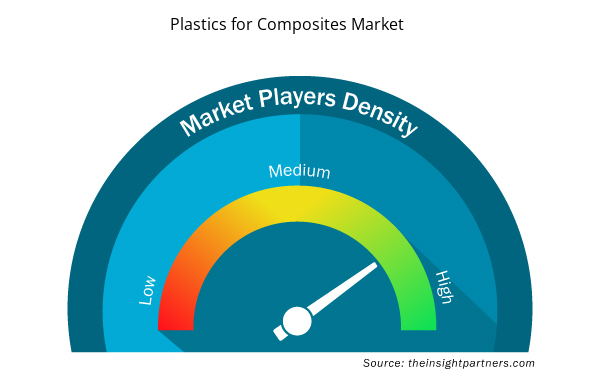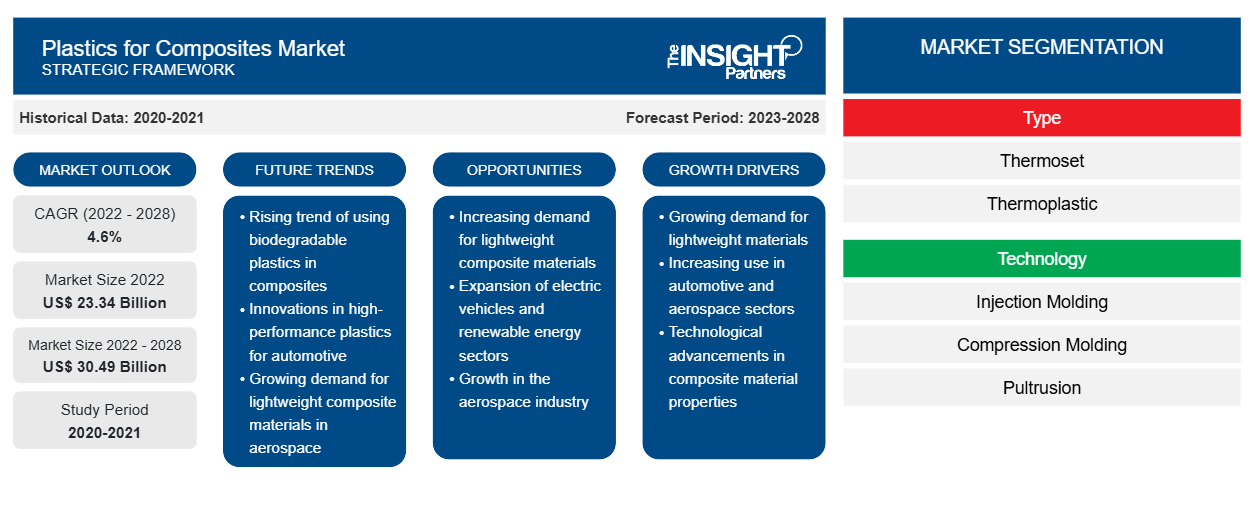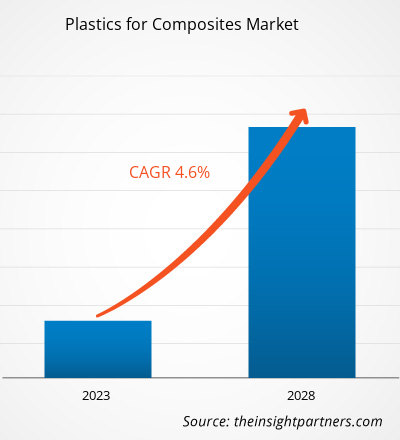复合材料用塑料市场预计将从 2022 年的 233.3724 亿美元增长到 2028 年的 304.9085 亿美元;预计 2022 年至 2028 年的复合年增长率为 4.6%。
复合材料是由两个或多个化学和物理上不同的相组成的材料,这些相由一个独特的界面隔开。大多数商业生产的复合材料使用聚合物基质材料,通常称为树脂溶液。常用的聚合物基质包括聚酯、乙烯基酯、环氧树脂、酚醛树脂、聚酰亚胺、聚酰胺、聚丙烯和聚醚醚酮 (PEEK)。低成本、易加工、耐化学性好和比重低是聚合物基质的主要优点。
建筑和施工活动以及航空航天和军事应用中复合树脂的使用量不断增加,这促进了塑料复合材料市场的增长。此外,汽车制造对轻质材料的需求,以提高燃油效率,是推动市场扩张的另一个因素。此外,对热塑性树脂的需求不断增长,对塑料复合材料市场的整体增长做出了重大贡献。刚性纤维和更高的耐热性、抗裂性、高抗撞击性和坚韧的聚合物基质是聚合物复合材料的主要特性,推动了它们的普及。可再生能源发电投资的增加可能会在未来几年引发对聚合物复合材料的需求。
定制此报告以满足您的需求
您可以免费定制任何报告,包括本报告的部分内容、国家级分析、Excel 数据包,以及为初创企业和大学提供优惠和折扣
- 获取此报告的关键市场趋势。这个免费样品将包括数据分析,从市场趋势到估计和预测。
市场洞察
汽车和航空航天工业需求不断增长推动塑料复合材料市场增长
复合树脂用于各种应用,包括建筑和基础设施、交通运输、电气和电子、风能、管道和储罐、海洋、航空航天和军事。先进材料对于提高现代汽车的燃油经济性同时确保安全性和性能至关重要。由于加速较轻物体所需的能量比加速较重物体所需的能量少,轻质材料为提高车辆效率提供了极好的潜力。因此,汽车行业对制造节油、轻型汽车的复合材料的需求很高,推动了塑料复合材料市场的增长。中国和印度等新兴经济体的终端使用行业是塑料复合材料需求增长的主要贡献者。对制造航空零部件的轻质材料的需求不断增加是塑料复合材料市场增长的另一个重要因素。飞机制造商正在努力扩大公务机和商用飞机的主要热塑性结构。他们是长纤维增强热塑性塑料的早期采用者。
类型洞察
根据类型,复合材料市场塑料细分为热固性塑料(聚酯、乙烯基酯、环氧树脂、聚氨酯等)和热塑性塑料(聚丙烯、聚乙烯、聚氯乙烯、聚苯乙烯、聚对苯二甲酸乙二醇酯、聚碳酸酯等)。2021 年,热固性塑料占据了较大的市场份额。热固性塑料是一种用于纤维增强复合材料的流行聚合物基质材料。热固性塑料的常见例子包括环氧树脂和聚酯。它们是主要的基质系统类型之一,专门用于航空航天工业。热固性基质复合材料比热塑性基质复合材料应用更广泛,因为它们在相对较低的温度(低于 100°C)下粘度较低,从而更好地促进树脂/纤维润湿过程。这些因素预计将推动热固性基质组件市场的增长。
朗盛股份公司、科思创股份公司、塞拉尼斯公司、英力士集团控股公司、大赛璐公司、巴斯夫股份公司、赢创工业股份公司、索尔维股份公司、沙特基础工业公司和阿科玛股份公司是复合材料市场的主要参与者。领先的参与者采用并购和产品发布等策略来扩大其地理覆盖范围和消费者基础。例如,2022 年 6 月,朗盛股份公司推出了一种基于“绿色”环己烷的聚酰胺 6 基质复合材料。
复合材料用塑料市场区域洞察
Insight Partners 的分析师已详尽解释了预测期内影响复合材料塑料市场的区域趋势和因素。本节还讨论了北美、欧洲、亚太地区、中东和非洲以及南美和中美洲的复合材料塑料市场细分和地理位置。

- 获取复合材料塑料市场的区域特定数据
复合材料用塑料市场报告范围
| 报告属性 | 细节 |
|---|---|
| 2022 年市场规模 | 233.4亿美元 |
| 2028 年市场规模 | 304.9亿美元 |
| 全球复合年增长率(2022 - 2028) | 4.6% |
| 史料 | 2020-2021 |
| 预测期 | 2023-2028 |
| 涵盖的领域 | 按类型
|
| 覆盖地区和国家 | 北美
|
| 市场领导者和主要公司简介 |
|
复合材料市场参与者的塑料密度:了解其对业务动态的影响
复合材料用塑料市场正在快速增长,这得益于最终用户需求的不断增长,而这些需求又源于消费者偏好的不断变化、技术进步以及对产品优势的认识不断提高等因素。随着需求的增加,企业正在扩大其产品范围,进行创新以满足消费者的需求,并利用新兴趋势,从而进一步推动市场增长。
市场参与者密度是指在特定市场或行业内运营的企业或公司的分布情况。它表明在给定市场空间中,相对于其规模或总市场价值,有多少竞争对手(市场参与者)存在。
在复合材料塑料市场运营的主要公司有:
- 朗盛公司
- 科思创公司
- 塞拉尼斯公司
- 英力士集团控股公司
- 大赛璐公司
免责声明:上面列出的公司没有按照任何特定顺序排列。

- 了解塑料复合材料市场的主要参与者概况
报告亮点
- 复合材料塑料行业的发展趋势有助于参与者制定有效的长期战略
- 公司采用的业务增长战略来确保发达市场和发展中市场的增长
- 2020 年至 2028 年全球复合材料用塑料市场定量分析
- 各行业对复合材料塑料的需求估计
- 波特五力分析说明了塑料复合材料行业买家和供应商的效力
- 了解竞争激烈的市场形势和复合材料用塑料的需求的最新发展
- 市场趋势和前景,以及影响复合材料塑料市场增长的因素
- 启发性战略支撑有关市场增长的商业利益,帮助决策过程
- 复合材料用塑料市场规模在各个市场节点
- 市场的详细概述和细分以及行业动态
- 各地区复合材料用塑料市场规模及增长机遇
“2028 年复合材料用塑料市场分析”是一项针对化学品和材料行业的专业深入研究,重点关注复合材料用塑料市场趋势分析。该报告旨在提供市场概述和详细细分。复合材料用塑料市场根据类型、技术和地理位置进行细分。根据类型,市场细分为热固性塑料(聚酯、乙烯基酯、环氧树脂、聚氨酯等)和热塑性塑料(聚丙烯、聚乙烯、聚氯乙烯、聚苯乙烯、聚对苯二甲酸乙二醇酯、聚碳酸酯等)。根据技术,市场细分为注塑、压缩成型、拉挤、树脂灌注等。在地理方面,市场分为五个主要区域——北美、欧洲、亚太地区、中东和非洲以及南美和中美洲。2021 年,亚太地区在复合材料用塑料市场中占据主导地位。预计该地区在预测期内的市场复合年增长率最高。亚太地区的汽车和建筑行业发展迅速。该地区是世界上人口最多的地区,也是世界上建筑业发展最快的地区之一。这些因素导致亚太地区对复合材料用塑料的需求量很大。
- 历史分析(2 年)、基准年、预测(7 年)及复合年增长率
- PEST 和 SWOT 分析
- 市场规模价值/数量 - 全球、区域、国家
- 行业和竞争格局
- Excel 数据集



Report Coverage
Revenue forecast, Company Analysis, Industry landscape, Growth factors, and Trends

Segment Covered
This text is related
to segments covered.

Regional Scope
North America, Europe, Asia Pacific, Middle East & Africa, South & Central America

Country Scope
This text is related
to country scope.
常见问题
The increasing utilization of plastics for composites in building & construction activity, aerospace, and military applications are some of the key factors that contribute to the growth of the market. In addition, the demand for lightweight materials from transportation, which in response improves the efficiency of fuel, is another factor propelling the expansion of the market. These factors are driving the plastics for composites market growth.
During the forecast period, thermoplastic is expected to be the fastest-growing segment. The growing adoption of thermoplastic within the automotive industry, rising demand for recyclable and fast-curing materials, increasing demand for automobiles, and growing penetration of composite materials by replacing metals are significant factors boosting the growth of the thermoplastic segment in plastics for composites market demand during the forecast period.
During the forecast period, the compression molding segment is expected to be the fastest-growing segment. The manufacture of various parts of electronic and automotive products has increased due to the increased demand for automotive and electrical products, particularly vehicles, mobile phones and tablets. The compression molding process is primarily used in the fabrication of these parts. These factors are expected to accelerate the growth of the compression molding segment of the plastics for composites market.
In 2021, the thermoset segment held the largest market share. Increased use of thermoset plastic in the aerospace and automobile industry due to their lower viscosity at relatively low temperatures (less than 100°C), which better facilitates the resin/fiber wetting process led to the dominance of the thermoset segment in the plastics for composites market.
The major players operating in the plastics for composites market are Lanxess AG, Covestro AG, Celanese Corp, INEOS Group Holdings SA, Daicel Corp, BASF SE, Evonik Industries AG, Solvay SA, Saudi Basic Industries Corp, and Arkema SA.
In 2021, Asia-Pacific accounted for the largest share of the global plastics for composites market. Growing demand from construction, wind power, electronics, and automotive industries led to the dominance of the Asia Pacific region in 2021.
Trends and growth analysis reports related to Chemicals and Materials : READ MORE..
The List of Companies - Plastics for Composites Market
- Lanxess AG
- Covestro AG
- Celanese Corp
- INEOS Group Holdings SA
- Daicel Corp
- BASF SE
- Evonik Industries AG
- Solvay SA
- Saudi Basic Industries Corp
- Arkema SA
The Insight Partners performs research in 4 major stages: Data Collection & Secondary Research, Primary Research, Data Analysis and Data Triangulation & Final Review.
- Data Collection and Secondary Research:
As a market research and consulting firm operating from a decade, we have published and advised several client across the globe. First step for any study will start with an assessment of currently available data and insights from existing reports. Further, historical and current market information is collected from Investor Presentations, Annual Reports, SEC Filings, etc., and other information related to company’s performance and market positioning are gathered from Paid Databases (Factiva, Hoovers, and Reuters) and various other publications available in public domain.
Several associations trade associates, technical forums, institutes, societies and organization are accessed to gain technical as well as market related insights through their publications such as research papers, blogs and press releases related to the studies are referred to get cues about the market. Further, white papers, journals, magazines, and other news articles published in last 3 years are scrutinized and analyzed to understand the current market trends.
- Primary Research:
The primarily interview analysis comprise of data obtained from industry participants interview and answers to survey questions gathered by in-house primary team.
For primary research, interviews are conducted with industry experts/CEOs/Marketing Managers/VPs/Subject Matter Experts from both demand and supply side to get a 360-degree view of the market. The primary team conducts several interviews based on the complexity of the markets to understand the various market trends and dynamics which makes research more credible and precise.
A typical research interview fulfils the following functions:
- Provides first-hand information on the market size, market trends, growth trends, competitive landscape, and outlook
- Validates and strengthens in-house secondary research findings
- Develops the analysis team’s expertise and market understanding
Primary research involves email interactions and telephone interviews for each market, category, segment, and sub-segment across geographies. The participants who typically take part in such a process include, but are not limited to:
- Industry participants: VPs, business development managers, market intelligence managers and national sales managers
- Outside experts: Valuation experts, research analysts and key opinion leaders specializing in the electronics and semiconductor industry.
Below is the breakup of our primary respondents by company, designation, and region:

Once we receive the confirmation from primary research sources or primary respondents, we finalize the base year market estimation and forecast the data as per the macroeconomic and microeconomic factors assessed during data collection.
- Data Analysis:
Once data is validated through both secondary as well as primary respondents, we finalize the market estimations by hypothesis formulation and factor analysis at regional and country level.
- Macro-Economic Factor Analysis:
We analyse macroeconomic indicators such the gross domestic product (GDP), increase in the demand for goods and services across industries, technological advancement, regional economic growth, governmental policies, the influence of COVID-19, PEST analysis, and other aspects. This analysis aids in setting benchmarks for various nations/regions and approximating market splits. Additionally, the general trend of the aforementioned components aid in determining the market's development possibilities.
- Country Level Data:
Various factors that are especially aligned to the country are taken into account to determine the market size for a certain area and country, including the presence of vendors, such as headquarters and offices, the country's GDP, demand patterns, and industry growth. To comprehend the market dynamics for the nation, a number of growth variables, inhibitors, application areas, and current market trends are researched. The aforementioned elements aid in determining the country's overall market's growth potential.
- Company Profile:
The “Table of Contents” is formulated by listing and analyzing more than 25 - 30 companies operating in the market ecosystem across geographies. However, we profile only 10 companies as a standard practice in our syndicate reports. These 10 companies comprise leading, emerging, and regional players. Nonetheless, our analysis is not restricted to the 10 listed companies, we also analyze other companies present in the market to develop a holistic view and understand the prevailing trends. The “Company Profiles” section in the report covers key facts, business description, products & services, financial information, SWOT analysis, and key developments. The financial information presented is extracted from the annual reports and official documents of the publicly listed companies. Upon collecting the information for the sections of respective companies, we verify them via various primary sources and then compile the data in respective company profiles. The company level information helps us in deriving the base number as well as in forecasting the market size.
- Developing Base Number:
Aggregation of sales statistics (2020-2022) and macro-economic factor, and other secondary and primary research insights are utilized to arrive at base number and related market shares for 2022. The data gaps are identified in this step and relevant market data is analyzed, collected from paid primary interviews or databases. On finalizing the base year market size, forecasts are developed on the basis of macro-economic, industry and market growth factors and company level analysis.
- Data Triangulation and Final Review:
The market findings and base year market size calculations are validated from supply as well as demand side. Demand side validations are based on macro-economic factor analysis and benchmarks for respective regions and countries. In case of supply side validations, revenues of major companies are estimated (in case not available) based on industry benchmark, approximate number of employees, product portfolio, and primary interviews revenues are gathered. Further revenue from target product/service segment is assessed to avoid overshooting of market statistics. In case of heavy deviations between supply and demand side values, all thes steps are repeated to achieve synchronization.
We follow an iterative model, wherein we share our research findings with Subject Matter Experts (SME’s) and Key Opinion Leaders (KOLs) until consensus view of the market is not formulated – this model negates any drastic deviation in the opinions of experts. Only validated and universally acceptable research findings are quoted in our reports.
We have important check points that we use to validate our research findings – which we call – data triangulation, where we validate the information, we generate from secondary sources with primary interviews and then we re-validate with our internal data bases and Subject matter experts. This comprehensive model enables us to deliver high quality, reliable data in shortest possible time.


 获取此报告的免费样本
获取此报告的免费样本